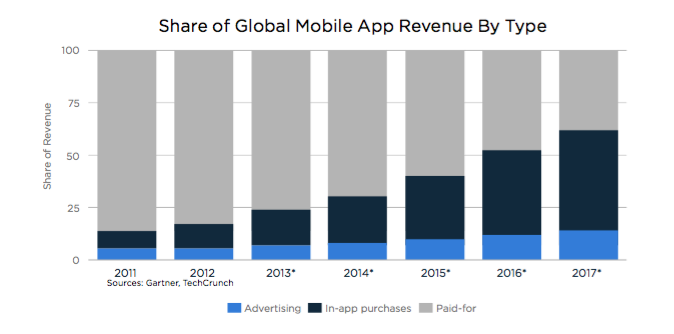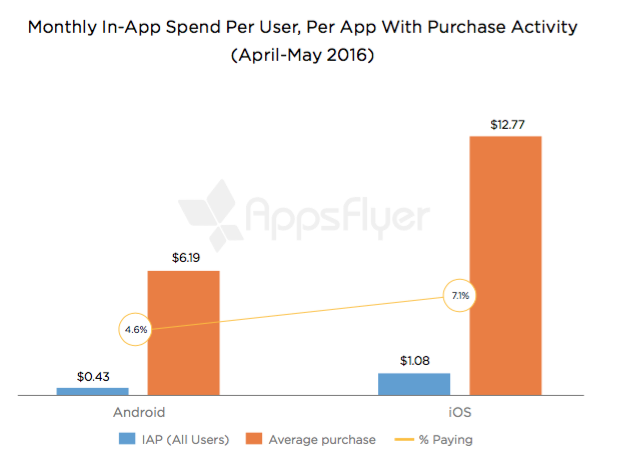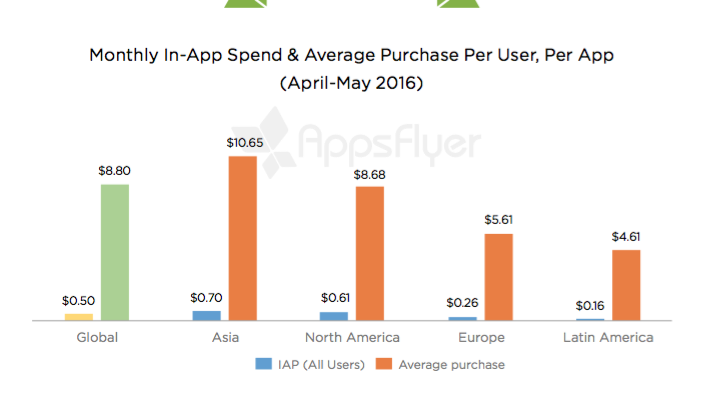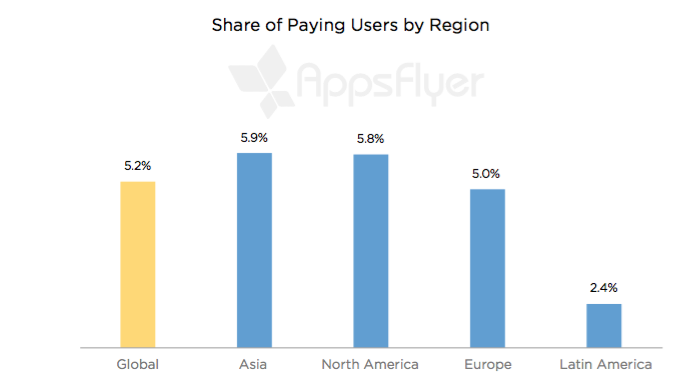It’s no secret that free-to-play games, even the most popular ones, rely on a small minority of paying players (especially high-spending “whales”) for revenues, and it’s always a challenge to find and attract users willing to spend money on virtual goods. However, AppsFlyer is helping to shed some light on the matter with a new report titled The State of In-App Spending, which examines the spending habits of mobile gamers from around the world. As it turns out, Apple iOS device users happen to be the biggest spenders.
The report first discusses monetization, with revenue generated by app developers between in-app advertising, premium models and purchases. Back in 2011, paid-for apps led the charge, but as of late, in-app purchases and advertising have taken over more than 50 percent combined compared to full-price apps. By next year, that number is expected to grow by an additional ten percent.

Perhaps one of the biggest find of the report deals with iOS versus Android spending, as the numbers indicate that users spend more on Apple’s platform. In-app purchases make up $1.08 compared to Android’s $.43, while the average purchase of gaming apps is at $12.77 for iOS and $6.19 for Android—double the amount.
The report also covered monthly in-app spend and average purchase per user divided by countries (for April/May 2016), and Asia scored big in this department, with the highest numbers on the chart. $.70 for IAP (all users) was noted in this country, along with $10.65 for average purchases. Meanwhile, other countries, like North America and Europe, reported lower amounts.

Asia has the highest number of paying users by region, barely beating North America by .1 percent (5.9 percent compared to 5.8 percent). They’re both higher than the 5.2 percent global average, with Europe close behind with five percent.

AppsFlyer also discussed “whales,” which make up 3.5 percent of overall gamers that make in-app purchases, but spend approximately 30 times more than the average gamer—by a rough comparison of $9.39 vs. $.32 a month per gaming app. It also noted that North American shoppers generally spend about $2.68 on in-app purchases per title, with a 2.5 times higher total than the average European app shopper. It also beat Asia by three times the amount. The average in-app purchase value comes up to $42.82, which is four times what Asian customers spend, which is around $11.13.

AppsFlyer’s head of marketing, Ran Avrahamy, sat down with [a]listdaily to discuss the report more thoroughly, providing further insight on iOS and Android spending habits.

What do you believe accounts for such a significant spending difference between iOS and Android users?
iOS users have always outspent Android users. A large part of the reason why could be the type of person who buys an iOS device, which tends to be fairly expensive, compared to the type of person who buys an Android device, many of which are on the more affordable end of the spectrum. Some people have speculated that iOS users spend more because most iOS users already have their credit card and payment information loaded into iTunes, so the payment process is more streamlined, but we believe that is less of a factor these days.
Does the comparatively higher number of Android users make up the difference?
Yes, that is certainly a factor that developers must consider. iOS users may spend more, but Android’s lead in overall market share makes the platform impossible to ignore from a business and revenue opportunity perspective.
Is there something particular about the iOS platform that encourages higher spending? Conversely, is there something about Android that leads to lower spending?
The more streamlined payment process in iOS could certainly be one factor, but as mentioned earlier we don’t feel it’s a significant factor. The Android platform has improved greatly over the years to make in-app payments easier and more friction-free, so the differences are more likely attributable to differences in user types.
Do you think there is anything that can be done by either app or platform developers to grow the Android spending numbers?
One thing that developers can do is try targeting Android audiences that are likely to be more affluent, whether that means targeting them by device type (going after owners of high-end Android smartphones like the Samsung Galaxy S7, the Nexus 6P, or the HTC 10), location (by targeting countries that spend the most, like those in Asia), age, income or other available parameters.
Given the findings, is it better for developers to focus mainly or exclusively on the iOS platform?
While iOS users typically spend more, Android’s market share is much greater than iOS’—and according to new reports, it is still growing. So developers would be foolish to completely ignore the majority of users. In fact, for certain categories—like utility apps—it might make sense for developers to focus solely on Android, since users spend much more often within this category on Android than they do on iOS. There can also be lower costs for paid promotion of Android apps, which broadens the potential for attracting users that do have a high lifetime value.
Overall, we recommend that a balanced approach makes the most sense to build a sustainable business. Developers should always be exploring, testing and measuring the activities that drive the highest quality users to their apps on both platforms.

